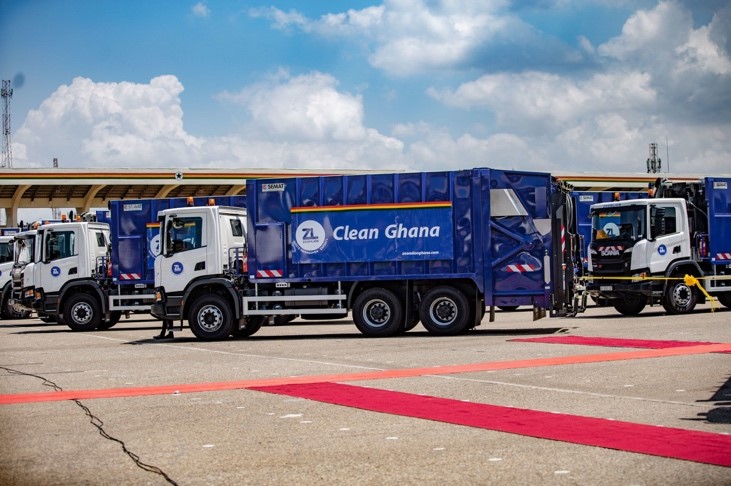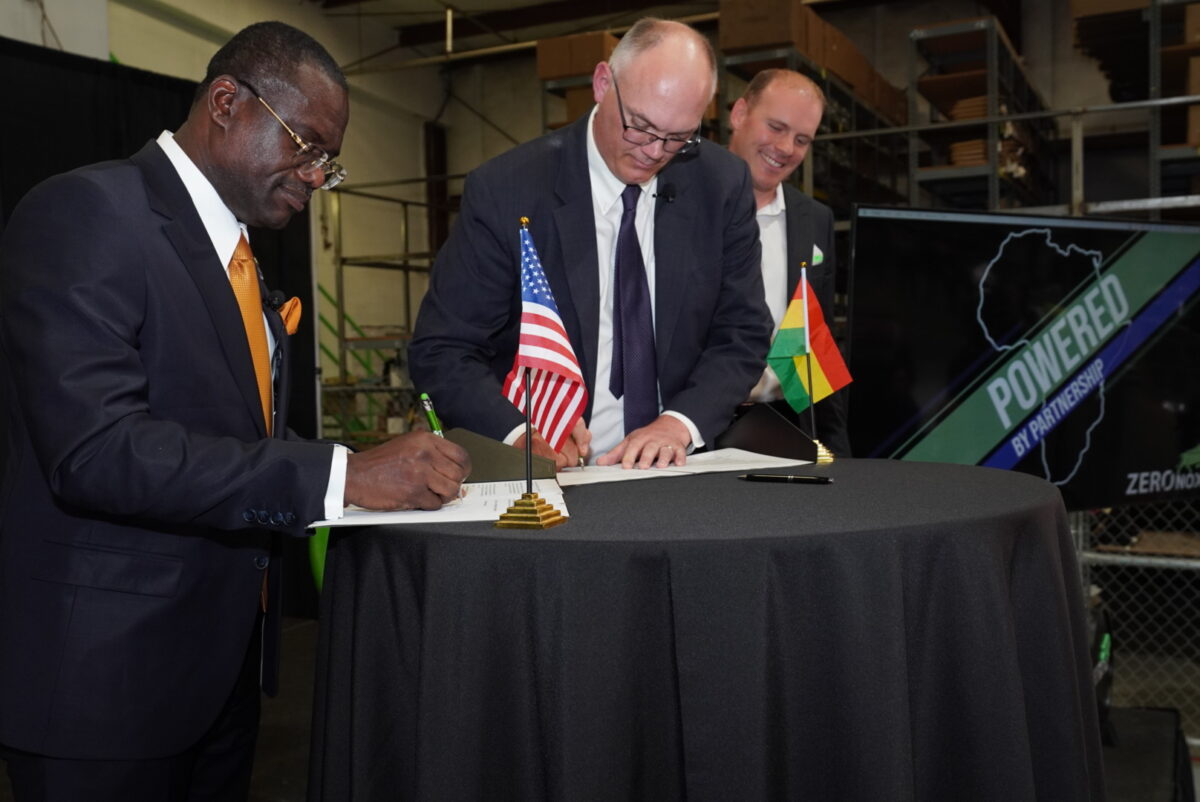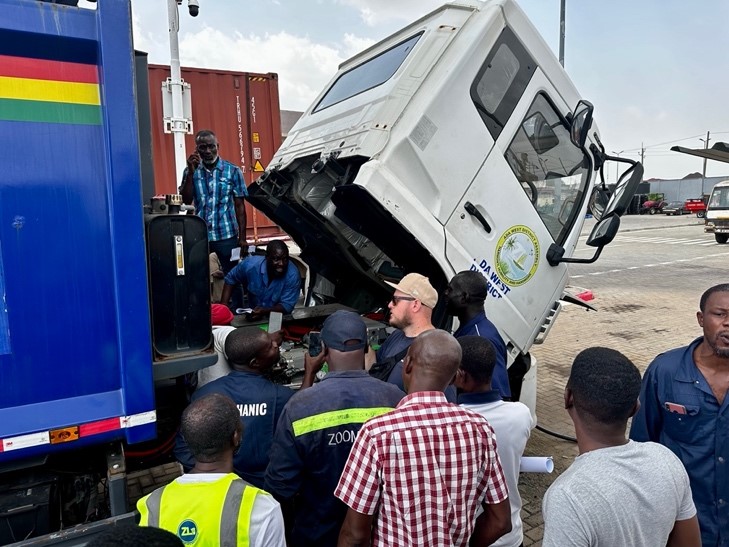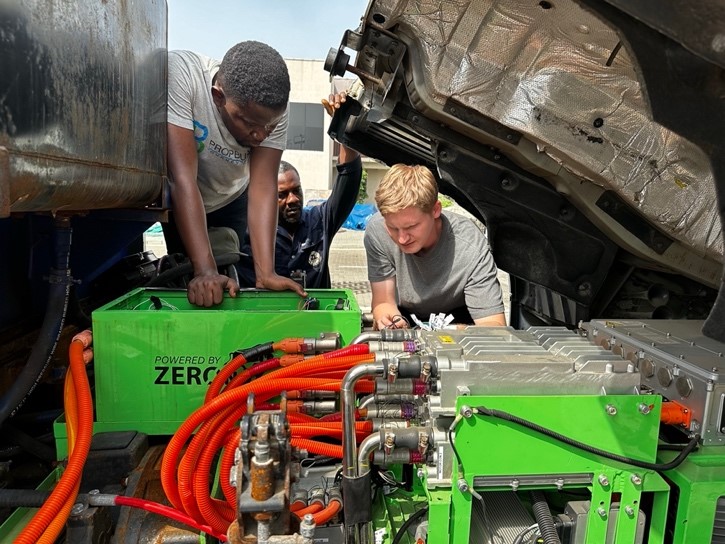In the spirit of the COP 30 Presidency’s call for a global mutirão – a collective effort to mobilize climate action – the Business Council for Sustainable Energy (BCSE) will lead a business delegation to COP 30 in Belém, Brazil that will bring forward credible solutions, partnerships, investments, and ideas to accelerate the energy transition and decarbonize agriculture, buildings, industry, and transportation. This case study is part of BCSE’s Granary of Solutions to deliver emissions reductions, increase resilience, and meet energy transition goals worldwide.
Highlights:
- The world’s largest fleet retrofit electrification project is transforming 1,000 internal combustion engine (ICE) refuse trucks in Ghana into zero-emission vehicles
- Workforce training program upskills 600 local mechanics to EV technicians
- 400,000 metric tons of CO2 abated from driving zero emission
Case Study:
Zeronox and the Jospong Group have partnered to execute the world’s largest fleet retrofit electrification project, transforming 1,000 internal combustion engine (ICE) refuse trucks in Ghana into zero-emission vehicles using the proprietary Electric Powertrain Platform (ZEPP). With an initial pilot phase complete, the project is now entering mass deployment. The transformation delivers massive carbon reductions (~400,000 metric tons of CO₂ abated), ~$300 million in projected savings, and a payback period of under three years. This groundbreaking initiative highlights the viability of electrification in emerging markets and sets a model for scalable, sustainable fleet transformation in Africa and beyond.

Mass Production Specs (Post-Pilot Fleet)
- What: 1,000 class 8 swing arm skip trucks; single axle compactor trucks; dual axle compactor trucks
- Route: 100 km daily driving distance for single and dual axel compactors
- Route: 240 km daily driving distance for swing-arm skip trucks
- Payback period: 3 years
- Charging: 120 kW dual-gun DC EVSE. 5h for swing arm/2.5h for compactor trucks
- Annual fuel cost savings: $40 million USD with annual maintenance savings of ~$20 million
- CO2 savings: 400,000 metric tons abated from driving zero emission
- Who: 600 mechanics upskilled to EV technicians
Timeline
2021: Initial feasibility visit conducted in Ghana by Zeronox to assess electrification opportunities for Zoomlion’s waste fleet.
2022: Zeronox and Jospong formalize partnership: MOU signed, Jospong team visits California, and commercial contract executed.
2023: First pilot trucks shipped from Ghana to California for retrofitting at Zeronox’s facility, achieving successful Alpha truck retrofit.
2024: Local technician training begins in Ghana, led by Zeronox; charging infrastructure planning and strategy work conducted to enable fleet deployment.
2025: Mass production and large-scale deployment of electrified Zoomlion trucks underway following successful in-country validation.

Who Was Involved
Zeronox – The technology provider and system integrator behind ZEPP; responsible for design, retrofit, and validation.
Jospong Group – One of Ghana’s largest conglomerates; key implementation partner managing the fleet transition.
Zoomlion Ghana Ltd. – Jospong’s waste management arm; operates the electrified trucks.
Local Ghanaian Engineers and Mechanics – Participating in EV technician upskilling programs.
Curriculum Partners – Educational institution partners assisting with local training such as Porterville College and the Jospong Academy.

Lessons Learned
Design for the duty cycle: Electrification efforts are most successful when they focus on predictable and repetitive duty cycles, such as consistent routes. This ensures optimized battery usage and range management. The relative lower average speed of the refuse trucks along with stop-and-start operations were ideal to recapture energy through regenerative braking.
Plan charging infrastructure early: Charging logistics must be embedded in fleet operations to avoid downtime. Charging infrastructure must be strategically planned and implemented to meet the fleet’s operational needs. This includes access to high-quality, reliable charging stations and potential on-site energy storage solutions.
Build local capacity: Transitioning from internal combustion engine (ICE) vehicles to electrified fleets requires upskilling existing mechanics into certified electric vehicle (EV) technicians. Providing specialized training for local mechanics and EV drivers are critical for safety, maintenance, and long-term success. Early buy-in from drivers, managers, and city officials accelerated adoption and reduced resistance.
Retrofits can scale quickly: With pilot success, 1,000 trucks are scheduled to be electrified – demonstrating a replicable model for emerging markets.
Local supply chain and support: Developing a local supply chain for spare parts and technical support reduces downtime and dependence on imports, ensuring quicker resolutions to maintenance needs.

